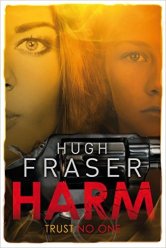
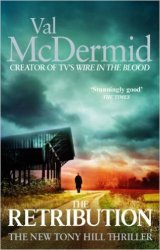 The Wire In The Blood is Val McDermid’s second novel featuring clinical psychologist Tony Hill and DI Carol Jordan. The first book in the series, The Mermaids Singing, marked something of a change for McDermid; already the author of several popular series of crime novels, she took things in a much darker direction with Mermaids. The Hill/Jordan books focus on dangerous and sadistic serial killers, with Jordan, Hill and their colleagues often in grave danger. There’s more emphasis on both the police procedure and the psychological profile of the perpetrators.
The Wire In The Blood is Val McDermid’s second novel featuring clinical psychologist Tony Hill and DI Carol Jordan. The first book in the series, The Mermaids Singing, marked something of a change for McDermid; already the author of several popular series of crime novels, she took things in a much darker direction with Mermaids. The Hill/Jordan books focus on dangerous and sadistic serial killers, with Jordan, Hill and their colleagues often in grave danger. There’s more emphasis on both the police procedure and the psychological profile of the perpetrators.
The Wire In The Blood features Jacko Vance, a very well-known, very well-liked TV personality who is as famous for his charity work as he is for his TV work. Beyond his public fundraising work, he also gets involved behind the scenes – he does portering and the like in hospitals, and he spends private time with the sick and the dying. If that sounds unsettlingly familiar, it should – McDermid has acknowledged that Vance was inspired, at least in part, by the rumours in the journalism world about Jimmy Saville, years before his death and public disgrace.
Vance is a British hero, an ex-Olympic athlete who lost an arm saving a man following a car crash. He’s driven, motivated – and a psychopath. This isn’t a spoiler, because The Wire In The Blood isn’t a whodunnit. It is, in parts, a howdunnit and a whydunnit, and even a did-anyone-do-it, but mostly is an intricate cat and mouse game between Vance and Hill, Jordan and their team.
Tony Hill is setting up a new national profiling team of young and keen police officers, despite some very clear reservations from more senior officers. He sets his team a paper exercise – to look at a large selection of missing persons cases and see if they can find anything using their new knowledge and skills. One does – fiercely competitive Shaz Bowman connects a series of missing teenagers with local publicity appearances by Vance. When the idea isn’t taken as seriously as she would wish, Bowman continues her investigation outside of official channels, with devastating consequences.
Meanwhile, in Yorkshire, Jordan’s applying some profiling techniques of her own in her new job, and causes some ruffled feathers when she spots a pattern of arson that her team have missed. Given the book was written in 1997, it’s hardly a surprise that Jordan’s also facing quite explicit, as well as much less overt, sexism from many of her colleagues and seniors.
The relationship between Jordan and Hill is a thing of fragile, painful beauty. There’s clearly something there, but it seems to be neither properly romantic, nor sexual, in nature. “Longing” is perhaps the word that springs to mind. Their relationship seems to be drawing them together at the same time as it keeps them well apart. There’s so much unspoken here between them.
The Wire In The Blood is violent, and unflinching, and at times painful to read; it’s also gripping and densely-layered and a bloody good read.
The Retribution is the seventh book in the series (and McDermid’s 25th novel), and is in many ways a direct sequel to The Wire In The Blood – although many years and four books worth of events sit between them. I’ve read most, but not all, of the other books in the series, but none of them recently, so I was glad that I’d re-read The Wire In The Blood a few days before starting The Retribution – but McDermid’s mastered the difficult art of giving enough backstory that it’s not strictly necessary to have read the previous books, without weighing down the book with excessive exposition.
16 years after The Wire In The Blood, and Jacko Vance is in prison. He killed – tortured, raped and murdered – several teenage girls, and he tortured then murdered a police officer. He was not convicted of all offences, in part because he persuaded a long-term acquaintance – perhaps better described as an unquestioning fanboy – to perjure himself at the trial. Appeals, human rights cases and a charmed psychologist have left Vance is a relatively good position. He’s in general population, he’s got the best prosthetic arm money can buy (which means it’s disconcertingly lifelike), and he’s got prisoners who will do his bidding. Most importantly, he’s about to be given day release for work experience…
Thus begins an even more brutal, vicious and bloody cat-and-mouse game between Vance and Jordan/Hill.
Hill and Jordan are working separately, both facing challenges as usual, but their relationship (such as it is) seems to be on an even keel. It’s still ambiguous – more than platonic, less than romantic, definitely not sexual. As an aside, Hill’s impotence is noted as having been an issue for the two of them in the past, and it’s a long-running thread in the series; a motif for Hill’s psychological state and reaction to both his formative years and his chosen profession.
As Vance starts enacting his long-planned, brutal revenge, Hill and Jordan – and the people around them – are facing problems that seem very familiar: senior officers who either don’t support them or act against them, colleagues who doubt their effectiveness in the face of overwhelming evidence, explicit bigotry… it’s notable reading the two books back-to-back how little seems to have changed in the culture of their working environment.
The one element of the book I found puzzling was the B story, involving a series of murders that Jordan’s team investigate. It felt like a storyline that could have been expanded into the main story of a novel, but here is treated as something of a filler, it’s primary narrative purpose apparently to create a tension between competing demands on the time and attention of Jordan and her team. But as such, it conversely feels a bit overdone – presumably most Major Investigation Teams handle more than one case at a time as a matter of course? So it feels like it falls between two stools; not quite done full justice as a storyline in itself, but also something rather more than it needs to be to fulfil it’s purpose.
This book is as least bloody an unflinching as it’s predecessor but the ending is curiously low-key. After escalating rage and violence, the end comes with little fanfare and something close to banality. Most challenging to the reader – expectations set by the conventions of the genre – is that the climax of the action takes place “off page”. The reader and the protagonists find out what’s happened in the same way – someone tells them. It’s a brave choice, compounded by the emotional climax of the book being equally low key; the fireworks have come before, the end, as with so much between Jordan and Hill, is in the negative space and all that’s left unspoken.
At the time of reading, I felt quite unsatisfied by this state of affairs. But some time to reflect, and I’m left pondering whether my instinctive reaction was fair. As with Yrsa Sigurdardottir’s Last Rituals, perhaps my reaction is too conditioned by a lifetime’s exposure to the common tropes and conventions of the genre; perhaps it’s not necessary for a whodunnit to be a race against time before the murderer kills again, perhaps a crime thriller doesn’t have to finish with blood and fireworks, but can – like so much of life – happen while we’re looking the other way, and leave us feeling traumatised and bereft rather than happy and fulfilled.
There’s two more Hill/Jordan novels waiting to be read, and both are on my TBR pile; I’m looking forward to seeing how McDermid brings her protagonists back from the cliffedge she just apparently shoved them over.
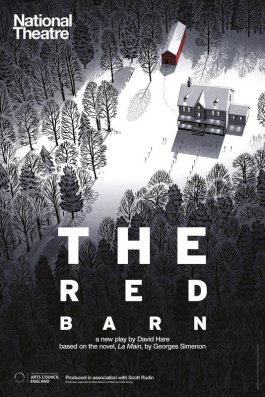 Two couples leave a party together in a terrible snow storm; only three people make it back to the house – thus starts The Red Barn, David Hare’s new play based on La Main, by Georges Simenon (he of Maigret fame).
Two couples leave a party together in a terrible snow storm; only three people make it back to the house – thus starts The Red Barn, David Hare’s new play based on La Main, by Georges Simenon (he of Maigret fame). Finding ourselves in London for a weekend, and at something of a loose end on the Saturday, I fell back on a tried and tested diversion – seeking cheap theatre tickets. I struck gold, with half-price tickets stalls seats (one row behind the top price section) for a matinee of Stephen Jeffreys’ The Libertine. This run, at the Theatre Royal Haymarket, stars Dominic Cooper in the eponymous role originally played by John Malkovich, and later portrayed by Johnny Depp in the film.
Finding ourselves in London for a weekend, and at something of a loose end on the Saturday, I fell back on a tried and tested diversion – seeking cheap theatre tickets. I struck gold, with half-price tickets stalls seats (one row behind the top price section) for a matinee of Stephen Jeffreys’ The Libertine. This run, at the Theatre Royal Haymarket, stars Dominic Cooper in the eponymous role originally played by John Malkovich, and later portrayed by Johnny Depp in the film. 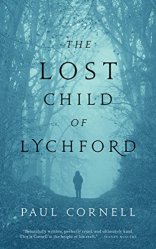 A stressed Church of England vicar is preparing for her first Christmas in her rural Cotswold parish, Lychford. Between well-meaning parishioners sympathising that she has to work “more than one day a week” in the festive season, a determinedly awkward couple insisting on a bizarrely complicated Christmas Eve wedding, and that bloody Greg Lake song everywhere, Lizzie’s just about reached breaking point. And then she sees a ghost.
A stressed Church of England vicar is preparing for her first Christmas in her rural Cotswold parish, Lychford. Between well-meaning parishioners sympathising that she has to work “more than one day a week” in the festive season, a determinedly awkward couple insisting on a bizarrely complicated Christmas Eve wedding, and that bloody Greg Lake song everywhere, Lizzie’s just about reached breaking point. And then she sees a ghost.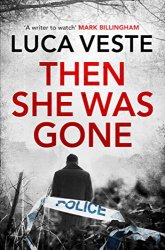 A man is mugged whilst walking his infant daughter; as he slips into unconsciousness, he realises his daughter’s been taken. But as the police try to investigate the apparent kidnap, it becomes clear that there’s no sign he ever had a daughter, no evidence to support his story about his recently-ended relationship, and no sign of the woman he claimed to have been living with – but enough blood in the house he used to live in to suggest an adult was killed there…
A man is mugged whilst walking his infant daughter; as he slips into unconsciousness, he realises his daughter’s been taken. But as the police try to investigate the apparent kidnap, it becomes clear that there’s no sign he ever had a daughter, no evidence to support his story about his recently-ended relationship, and no sign of the woman he claimed to have been living with – but enough blood in the house he used to live in to suggest an adult was killed there…

 A wealthy German history student living in Iceland is found dead, strangled, eyes gouged out and a strange symbol carved into his flesh. The student, heavily into witchcraft, body modification, erotic auto-asphyxiation, has been wedged into cupboard at his university, and is found when his body lands (messily) on top of a rather arrogant academic.
A wealthy German history student living in Iceland is found dead, strangled, eyes gouged out and a strange symbol carved into his flesh. The student, heavily into witchcraft, body modification, erotic auto-asphyxiation, has been wedged into cupboard at his university, and is found when his body lands (messily) on top of a rather arrogant academic.
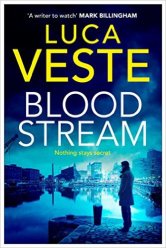 Bloodstream
Bloodstream